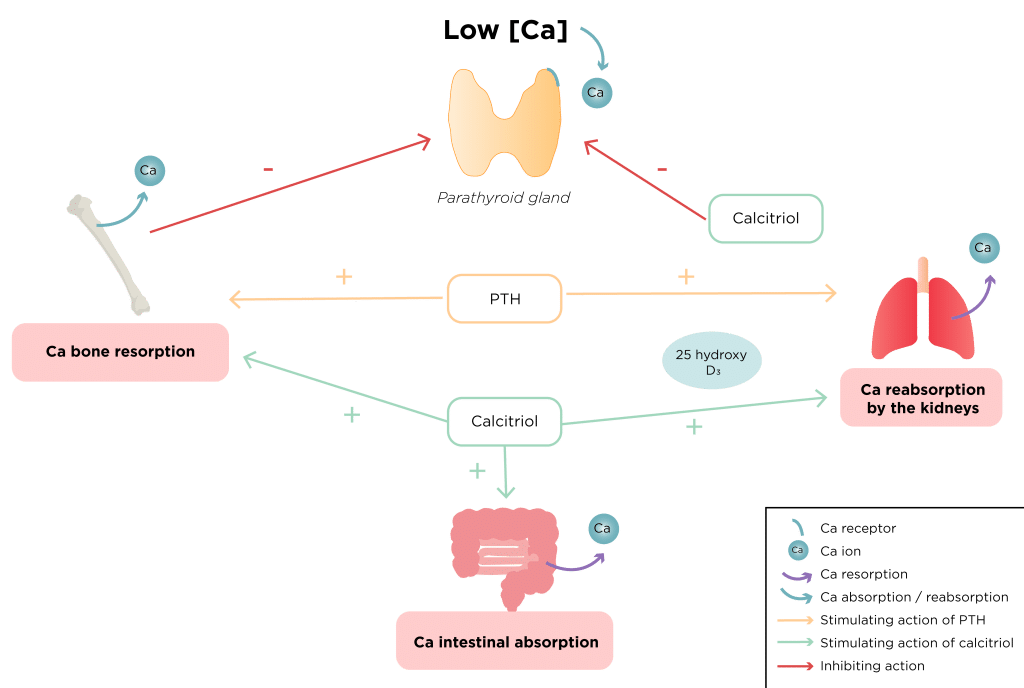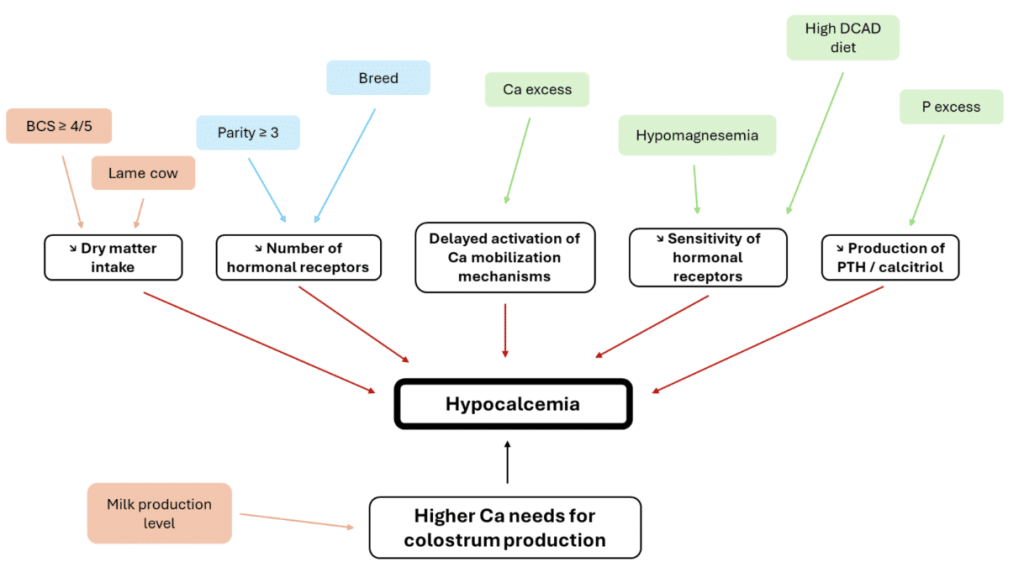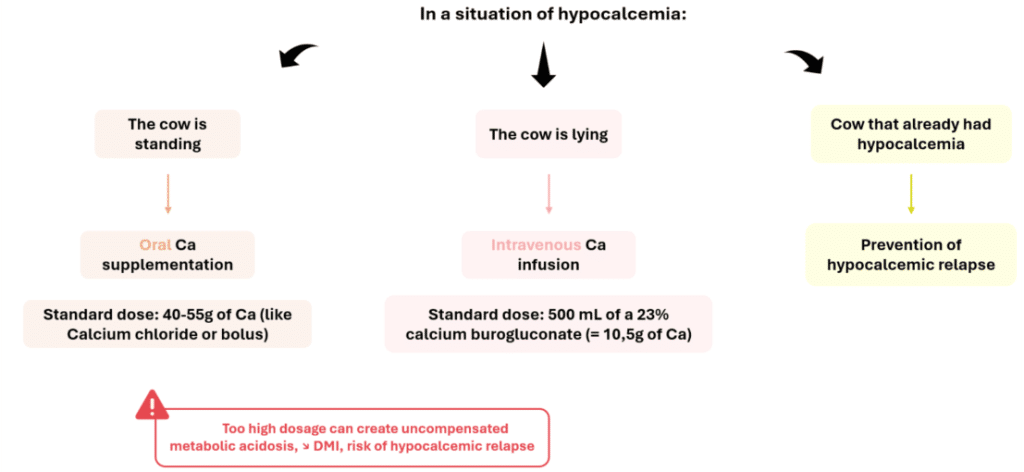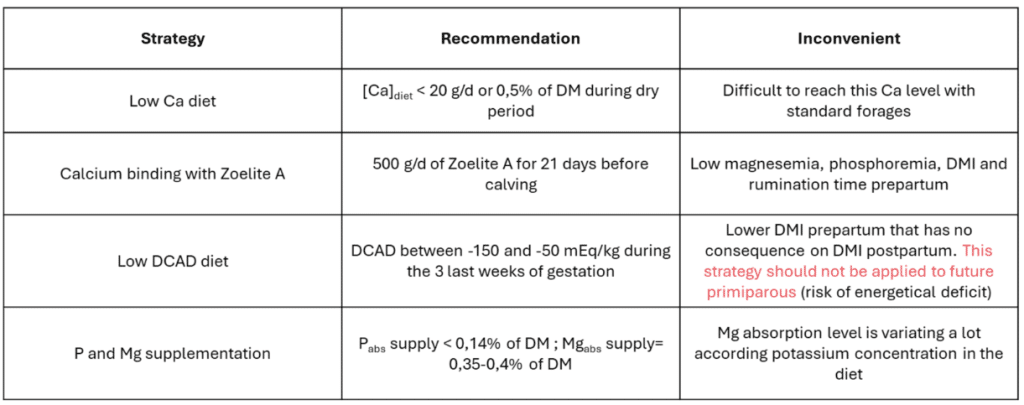Calcium (Ca) is the most abundant mineral in animal body. As it is essential for many mechanisms in animal’s life, Ca supplementation is key for ruminant nutrition. Thus, hypocalcemia which is a drop of blood Ca concentration linked with a sudden increase in Ca demand in early lactation, is a well-known problematic for breeders. Mostly observed in dairy animals, hypocalcemia, or milk fever, has many consequences on animal health and reproductive performance but also on farmers’ incomes. As milk fever costs on average 200-300 €/cow and subclinical hypocalcemia costs 115 €/cow, prevention of hypocalcemia took a considerable importance through different farm management strategies.
What is hypocalcemia? What are its causes and consequences? And how to prevent it?
1. Role of calcium and requirements of dairy cattle
1.1 Role of calcium in dairy animals
Ca represents 1.9% of the body weight. More than a constituent of milk (1.1-1.45 g of Ca needed to produce 1 kg of milk ; Bodin, 2020), Ca is critical for several physiological processes like bone formation, muscular contraction or activation of enzymatic and cellular metabolisms.
1.2 Calcium requirements of dairy cattle
Ca requirements of dairy cattle are expressed in terms of absorbable Ca (Caabs). Caabs represents the part of Ca that is finally absorbed by the animal and usable for its needs. Ca requirements for a dairy cow corresponds to its needs for maintenance, gestation and lactation.
Ca requirements of lactating dairy cow and dry cow are shown in Table 1. Linked with the start of milk production, there is a sudden increase in Ca needs just after calving. In normal situation, homeostatic mechanisms can adapt to this new demand of Ca and keep good body functions.

Table 1: Calcium requirements for lactating and dry cow (adapted from Bodin, 2020).
*Ca needs for lactating cow are for an Holstein cow weighing 700 kg and producing 25 kg milk /day. Ca needs for dry cows are for a dry cow of 700 kg at 278 days of gestation.
1.3 Calcium mobilization mechanisms
To meet the peak of Ca demand, the cow can mobilize Ca from its bones, increase intestinal absorption and decrease excretion by the kidneys. All these mechanisms are determined by hormonal activity of parathormone (PTH), calcitriol (or 1,25-(OH)2-vD, the active form of vitamin D) and, to a lesser degree, calcitonin. Indeed, a low blood Ca concentration will stimulate the production of PTH by the parathyroid gland that is responsible for a higher resorption of Ca from bones, a lower excretion of Ca by the kidneys and stimulation of calcitriol synthesis. Then, calcitriol stimulates Ca absorption in the intestine (Figure 1).

Figure 1: Hormonal regulation of calcium mobilization mechanisms (adapted from Bodin, 2020).
If the cow does not manage to activate all these mechanisms, Ca demand is not met and hypocalcemia can occur.
2. Appearance of hypocalcemia in dairy cows
2.1. Definition of hypocalcemia
Hypocalcemia corresponds to a low blood calcium concentration just after calving. A low blood Ca concentration after calving is normal, as colostrum and milk production create an sudden increase in Ca excretion (from 10 g/d to 30 g/d ; Oetzel et al., 2024). But in normal conditions, Ca concentration should be back within 4 days. In the literature, threshold to define hypocalcemia is set for a Ca blood concentration of 85 mg/L (Oetzel et al., 2024). There are two types of hypocalcemia: clinical hypocalcemia, also called milk fever and subclinical hypocalcemia (SCH). Milk fever and SCH, that usually occur just after calving or during the 3 following days, can be distinguished with the apparition or not of symptoms. Table 2 shows a classification of fresh cows under different situations of hypocalcemia based on blood Ca concentration dynamics.

Table 2: Categorization of the different calcium dynamic groups (adapted from Abuelo, 2025).
1Ca concentration ; 2 Days in milk.
Normocalcemic: cow with a normal blood calcium concentration. Dyscalcemia: anomaly of blood Ca concentration.
If milk fever, which is characterized by the appearance of clinical signs, affects 2-5% of periparturient dairy cows, SCH (that is more discreate) is much more present in herds as 25-50% of early lactation are affected (Abuelo, 2025).
2.2. Factors increasing the risk of hypocalcemia
More than intrinsic parameters like parity, productivity or breed, the risk of hypocalcemia can be impacted by different nutritional conditions.
2.2.1. Intrinsic factors of risk for hypocalcemia
Several studies showed that the risk of hypocalcemia increases with the parity of the cow. The diminution of calcitriol receptors with older cows could explain the higher sensitivity of older cows to hypocalcemia. Animal breed can also impact the risk of hypocalcemia, with Jersey cows that are more at risk than Holstein cows for example. An hypothesis to explain this observation could be based on milk production/milk quality ratio that would justify an upper calcium demand for milk production in Jersey cow. Added to this, the risk of hypocalcemia increases with milk production level as Ca exportation in milk is 1.1-2.3 g/L.
2.2.2. Risk factors linked with cow nutrition
Several studies have highlighted that fat cows at calving would be more likely to develop hypocalcemia than cows with body condition score of 3-3.5 (BCS ; score from 1 to 5). A low dry matter intake could also favorize the appearance of hypocalcemia, as Ca demand would not be covered by the feed intake.
Talking about hypocalcemia, it is well-known that an adequate mineral supplementation during the dry period is essential. Indeed, calcium excess, by limiting the activity of PTH hormone, increases the risk of hypocalcemia (Figure 2). More than Ca content in the diet, phosphorous (P) must also be monitored. Dodin (2020) reported higher prevalence of hypocalcemia with diets rich in P. The mechanism associated with this observation is not so clear but P could inhibit the activity of α1-hydroxylase involved in calcitriol synthesis or impact the sensitivity of PTH receptors. Additionally, hypomagnesemia (which is a lack of magnesium (Mg)), also affects Ca mobilization by decreasing PTH synthesis and the sensitivity of its receptors. Last but not least, metabolic alkalosis which is induced by high dietary cation-anion difference (DCAD) diets increases the risk of hypocalcemia by lowering the sensitivity of PTH in the tissues.

Figure 2: Evolution of the risk of hypocalcemia with Ca content of the diet (adapted from Dodin, 2020).

Figure 3: Risk factors of hypocalcemia (adapted from Dodin, 2020). Intrinsic factors are in orange, nutritional factors in green and mixt ones are in blue.
3.Consequences and treatment of hypocalcemia
3.1. Consequences of hypocalcemia
Symptoms of milk fever are split in three phases: first, the cows has behavioral troubles like anxiety and locomotive disorders (this phase is rarely identified). Secondly, the cow is lying with possible constipation, hypothermia, tachycardia and lower ruminal contraction. The third phase is identifiable with same but stronger symptoms than phase 2. If no treatment is done, milk fever can lead to cow’s death (around 8% of affected cows ; Oetzel, 2011).
More than direct symptoms, hypocalcemia can cause other health and reproductive problems like dystocia, retained placenta, metritis, abomasum displacement or mastitis.
3.2. Treatment of hypocalcemia
Nowadays, treatments of hypocalcemia are well known, such as :

Figure 4: Treatment of hypocalcemia according to the severity.
4. Prevention of hypocalcemia
4.1. Preventive strategies based on dry cow nutrition
Different strategies of prevention for hypocalcemia can be observed on field. Most of them are based on dry cow feeding management (Table 3). Aim of these strategies is to better prepare cows to face the sudden peak of Ca demand by activating calcium mobilization mechanisms.
One first strategy is to decrease Ca content of the diet. With a low Ca diet, Ca mobilization mechanisms remain active during the dry period to avoid delayed reaction to Ca stress at calving. In the same idea, the use of Ca binders, like Zoelite A, can be a tool to decrease Ca concentration in the diet.
A second strategy is based on low DCAD diets. A low DCAD diet creates a compensated metabolic acidosis that favorizes the absorption of Ca in the gastrointestinal tract, improves the sensitivity of PTH receptors and increases Ca mobilization from bones. Charbonneau et al. (2006) showed that the occurrence of hypocalcemia is well correlated to urinary pH and DCAD value of the diet, calculated as DCAD (mEq/kg) = ([Na+] + [K+]) – ([Cl–] + 0.6 * [S2–]). Then, the choice of feed ingredient to put in the diet is key for this strategy, and feeding anionic salts, like magnesium chloride, can help to decrease the DCAD.
P and Mg supply are also important to prevent hypocalcemia by supplying these minerals to meet the requirements of the animals expressed by the NRC or INRAe for example. The objective is to avoid P excess and hypomagnesemia.

Table 3: Summary of feed strategies to prevent hypocalcemia.
With all these strategies, it is important to feed high Ca diet to cows just after calving.
4.2. Other preventive strategies of hypocalcemia
Other strategies can be adopted to prevent hypocalcemia like monitoring of body condition score (BCS < 4/5) and dry matter intake (optimal between 12-14 kgDM/d). Identifying more sensitive cows to strengthen prevention with them can also help. Finally, supplementing vitamin D or its precursors or administrating Ca as a prophylaxis are also existing solutions.
Phosphea’s solutions to manage hypocalcemia in dairy cow
As hypocalcemia or milk fever can impact health and reproductive performance of the animals, the risk of hypocalcemia is better and better managed, thanks to different strategies. Phosphea offers macro-mineral solutions to be part of preventive strategies like MAG26 and CALSEAPOWDER.
MAG26 is a magnesium phosphate that can be used in dry cow diets to bring high available magnesium with a low DCAD.
CALSEAPOWDER is based on 100% Lithothamnium calcareum. It can help optimizing low DCAD strategy thanks to its neutral DCAD and constitute a source of high available Ca after calving.
Bibliography :
BODIN, Fabien, Aurélien, Maxime, 2020. Importance et conséquences de l’hypocalcémie subclinique chez la vache laitière en péri-partum: exemple d’une clientèle vétérinaire des Vosges. Créteil : Ecole Vétérinaire d’Alfort.
OETZEL, Garrett R., 2024. Parturient Paresis in Cows – Metabolic Disorders. Merck Veterinary Manual [en ligne]. 2024. [Consulté le 22 août 2025]. Disponible à l’adresse : https://www.merckvetmanual.com/metabolic-disorders/disorders-of-calcium-metabolism/parturient-paresis-in-cows
OETZEL, G.R., 2011. Diseases of Dairy Animals | Non-Infectious Diseases: Milk Fever. In : Encyclopedia of Dairy Sciences [en ligne]. Elsevier. pp. 239245. [Consulté le 22 août 2025]. ISBN 978-0-12-374407-4. Disponible à l’adresse : https://linkinghub.elsevier.com/retrieve/pii/B978012374407400145X
(PDF) Hypocalcemia in Dairy Cattle, [sans date]. In : ResearchGate [en ligne]. [Consulté le 22 août 2025]. Disponible à l’adresse : https://www.researchgate.net/publication/385590308_Hypocalcemia_in_Dairy_Cattle